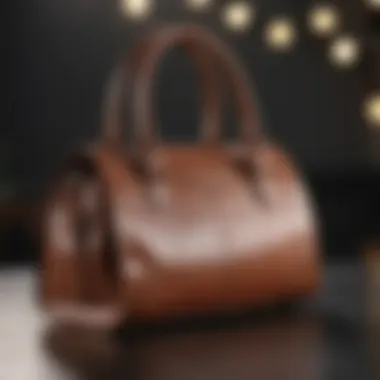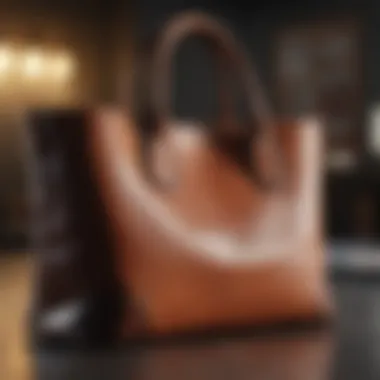Discovering Stylish Non-Leather Handbags for 2023


Intro
In recent years, the conversation surrounding fashion has increasingly shifted towards sustainability and ethical practices. As consumers become more aware of the environmental implications of their purchases, the demand for non-leather handbags has surged. This transition is not just a trend; it signals a deeper understanding of the impact that traditional materials have on our planet. Non-leather handbags are crafted from a variety of innovative materials that reduce reliance on animal products and promote more sustainable practices.
This article takes a closer look at the best non-leather handbags available today. By assessing their materials, styles, and the brands behind them, we aim to empower you as a conscious consumer. The handbags discussed herein combine functionality with aesthetics, offering choices that resonate with individual values and personal style.
Our exploration will guide you in understanding key trends in non-leather fashion, ensuring that your choices do not compromise on style or ethics. We will also provide practical tips on how to select the right handbag for your needs while promoting eco-friendly solutions. Through this analysis, we hope to assist you in making informed decisions that reflect your commitment to a more sustainable future.
Prelims to Non-Leather Handbags
The conversation surrounding fashion is evolving. Handbags serve not only as practical items for daily use but also as a reflection of our personal values and choices. Within this contemporary context, non-leather handbags are gaining considerable attention. This shift to non-leather options is not merely about avoiding animal products; it encapsulates a broader dialogue about ethical considerations, sustainability, and the modern consumer's responsibility toward the environment.
Defining Non-Leather Handbags
Non-leather handbags are crafted from materials that do not involve the use of animal hides or skins. This category includes a variety of innovative fabrics designed to mimic the look and feel of leather while being cruelty-free. Common materials include vegan leather, canvas, recycled materials, and synthetic fibers. The definition of non-leather handbags encompasses any bag that aligns with these criteria, ensuring that consumers can enjoy stylish options without compromising their ethical beliefs.
The Rise of Ethical Fashion
Ethical fashion has emerged as a response to growing concerns about environmental degradation and animal welfare. Consumers today are more informed and conscious of their purchasing decisions. As such, the rise of ethical fashion is a collective movement aimed at promoting fair labor practices, sustainable materials, and thoughtful consumerism. Non-leather handbags are a significant aspect of this movement, providing aesthetically pleasing alternatives that support a more responsible industry. The increasing number of designers committing to ethical practices reflects the shifting expectations of consumers.
Importance of Sustainable Choices
Making sustainable choices is critical in today's world. The fast fashion industry significantly contributes to waste and pollution. By opting for non-leather handbags, consumers not only reduce their ecological footprint but also support brands that prioritize responsible production methods. Choosing non-leather materials can be a step toward a more sustainable lifestyle. These choices resonate with the growing demand for products that have a minimal environmental impact while still offering style and functionality. In this way, non-leather handbags offer a practical solution for those wishing to marry fashion with sustainability.
Materials Commonly Used
The choice of materials significantly shapes the non-leather handbag market. This section examines the common materials used, underscoring their benefits and suitability. Understanding these materials offers insight into the practicality, ethics, and aesthetic value of non-leather handbags. As shoppers increasingly prioritize sustainability, knowing which materials align with these values can enhance decision-making for consumers.
Vegan Leather
Vegan leather is a popular alternative to traditional leather, crafted from synthetic materials or plant-based resources. It aims to mimic the look and feel of leather without using animal products. The main advantage of vegan leather is its cruelty-free nature. This aligns with the ethical values many consumers prioritize today. However, it is essential to differentiate between various types of vegan leather, as some may use harmful chemicals in their production. Selecting high-quality vegan leather, often made from materials like polyurethane, can offer both durability and an appealing look.
Canvas and Cotton
Canvas and cotton bags represent another significant material choice. These fabrics are made from natural fibers, which makes them biodegradable and sustainable. Canvas can be particularly tough, providing durability for everyday use. Cotton offers softness and comfort, appealing to those seeking a lightweight option. Moreover, they can often be printed with unique designs. The versatility of these materials makes them suitable for various styles. Despite these benefits, care must be taken to protect these fabrics from wear and tear, especially for those who want longevity.
Recycled Materials
Recycled materials are gaining traction in the handbag industry. These materials often come from post-consumer waste, like plastic bottles or textile scraps. Utilizing recycled materials not only helps reduce waste but also requires less energy in manufacturing than producing new material. Brands that focus on this approach can make a considerable positive environmental impact. Shoppers can feel good knowing their purchase contributes to a more sustainable economy. The unique stories behind these materials can also make these bags more appealing, showcasing a commitment to the environment.
Nylon and Polyester Alternatives
Nylon and polyester are prominent synthetic materials used in handbag production. Both are known for their strength and water-resistant properties. Nylon can provide lightweight options that are perfect for active lifestyles. Polyester also offers excellent durability, making it a suitable choice for daily use. However, these materials come from petroleum, raising concerns about sustainability. Therefore, it’s important to consider brands that use recycled nylon or polyester. Buying products made from recycled materials can help mitigate environmental impact, allowing for a balance between practicality and eco-friendliness.
Top Non-Leather Handbag Brands
In the growing world of ethical fashion, knowing about top non-leather handbag brands becomes significant for consumers. This section explores leading brands that prioritize sustainability, innovative designs, and affordability. Understanding these brands helps in making choices that align personal style with ethical values.


Overview of Leading Brands
Several brands have emerged as leaders in the non-leather handbag market. These brands focus on quality, sustainability, and unique styles. Selecting a bag from renowned brands ensures that you are making a responsible choice while also enjoying stylish options.
Some notable ones include:
- Matt & Nat: Renowned for their commitment to using recycled materials.
- Stella McCartney: Offers high-end fashion without the use of leather.
- TOMS: Known for their social responsibility and community impact.
- BAGGU: Focuses on simplicity and usability while being eco-friendly.
Brand A: Commitment to Sustainability
Brand A is a standout in the non-leather category, especially due to its sustainability initiatives. This brand utilizes vegan leather made from recycled plastics and other eco-friendly materials. Their commitment goes beyond just product choices; they focus on ethical labor practices and reducing carbon footprint throughout their manufacturing process.
Investing in a handbag from Brand A means that you support their mission to protect the environment while enjoying trendy styles. Their designs often feature clean lines and minimalist aesthetics, appealing to a wide audience.
Brand B: Innovative Design
Brand B emphasizes innovation in both materials and design. With a dedicated team of designers, they bring fresh styles that set trends rather than follow them. Their handbags are often multifunctional, catering to the dynamic lifestyle of modern consumers.
This brand prides itself on experimenting with non-traditional materials that offer durability without compromising style. User feedback often highlights the unique and fashionable approach of Brand B. This makes their handbags not just accessories but statements of personality and values.
Brand C: Affordability Meets Style
Brand C demonstrates that sustainability does not have to come at a high price. They offer a range of non-leather handbags that are budget-friendly while being stylish. This approach makes non-leather options accessible to more consumers, promoting a wider adoption of ethical fashion.
Their collections include everyday essentials to more fashionable choices, enabling shoppers to find what they need without overspending. Brand C often garners positive reviews for its blend of affordability and design effectiveness.
"Choosing non-leather brands often leads to discovering unique pieces that reflect individual style while supporting ethical practices."
In summary, exploring top brands in the non-leather handbag market reveals how innovation, sustainability, and affordability come together to meet modern consumer needs. Each brand presents its unique strengths, making them valuable options for conscious shoppers.
Styles and Trends
Understanding the latest styles and trends in non-leather handbags is essential for consumers. This market reflects an evolving landscape where aesthetics and practicality merge with ethical values. Non-leather handbags offer a wide variety of designs that appeal to diverse tastes. Consumers today seek bags that not only look good but also resonate with their ethical beliefs.
Today's handbag trends include vibrant colors, innovative materials, and functional designs. These aspects not only enhance the appearance of the bags but also ensure they meet the various needs of the user. As consumers become more conscious about sustainability, brands are responding with options that stand out while being environmentally responsible. Casual styles are in high demand, as people prioritize comfort and versatility.
Classic Totes
Classic totes remain a staple in non-leather handbag trends. They are widely appreciated for their practicality and timeless appeal. A good tote can hold many essentials – laptops, books, or even groceries. Brands use materials like recycled plastics and cotton for these large bags, enhancing both durability and sustainability. The use of bold patterns or elegant designs elevates the tote, making it suitable for various occasions.
These bags often come with multiple pockets, which aids in organization. Consumers like to have easy access to their belongings, and a well-designed tote supports this need. Moreover, the sheer size allows brands to experiment with textures and colors, appealing to consumers with different aesthetics.
Crossbody Bags
Crossbody bags have carved a niche for themselves among non-leather handbags. Their hands-free design is appealing, especially for those leading active lives. A crossbody bag allows for easy mobility, making it ideal for day-to-day use. Many people favor crossbody bags for travel, as they provide security and accessibility.
Varied styles are available, from sleek and minimalistic to more colorful and playful options. Usually made from vegan leather or canvas, these bags embody both style and utility. The adjustable straps allow for personalization, making them a versatile choice for different body types. This adaptability makes crossbody bags an attractive option for consumers seeking functionality without compromising on style.


Clutches and Evening Bags
Clutches and evening bags offer a different angle to the non-leather handbag landscape. Designed for more formal occasions, these bags serve as a statement accessory. A clutch often comes in sleek silhouettes, making them elegant companions for evening attire. Designers frequently utilize materials such as satin or high-quality synthetic leather to enhance their aesthetic appeal.
Despite their size, these bags also prioritize design elements like embellishments and chic closures. Many clutches will feature removable straps, allowing for versatility between a handheld or shoulder bag. While they may not offer the same storage capacity as totes or crossbody bags, clutches are prized for their ability to elevate an outfit effortlessly.
Investing in a non-leather handbag means embracing creativity, versatility, and ethical fashion.
Incorporating these styles and trends into wardrobe choices reflects a commitment to sustainability without sacrificing personal style. A well-rounded understanding of this segment can inform consumers as they navigate their handbag purchasing decisions.
Practical Considerations
When choosing a non-leather handbag, practical considerations play a significant role in ensuring satisfaction with the purchase. While aesthetics and sustainability are key attributes, the functionality and overall user experience must not be overlooked. This section focuses on several key aspects, including durability, maintenance, and storage solutions that will help the consumer make informed choices.
Durability of Non-Leather Materials
Durability is a critical factor in evaluating non-leather bags. Various materials exhibit different levels of strength and resilience. For instance, vegan leather can vary widely; some brands use high-quality PU leather, which offers a lifespan comparable to real leather. In contrast, lower-quality versions may wear quickly. Canvas and recycled materials can also be solid options, providing both style and longevity.
Some primary considerations include:
- Material quality: The caliber of the material directly influences how long the handbag will last.
- Usage requirements: Understanding regular use cases helps in selecting the right material that withstands daily wear.
- Weather resistance: Some materials, like nylon, resist water better than others. This is crucial for practical use in various conditions.
In consumer feedback, durability often stands out. Many users express contentment with well-made non-leather bags that offer longevity without compromising on style.
Maintenance and Care
Non-leather handbags typically require care specific to their materials. Unlike traditional leather, which may need conditioning and polishing, many non-leather options are easier to maintain. For example, canvas can usually be wiped clean with a damp cloth, while vegan leather may require mild soap and a soft cloth.
Important care tips include:
- Avoid harsh chemicals: Using strong cleaning agents can degrade the material.
- Store properly: Keeping bags in a cool, dry place helps to prolong their lifespan.
- Regular inspections: Checking for wear and tear allows for timely repairs or replacements.
Understanding these maintenance needs not only preserves the bag but ensures continued satisfaction over the years.
Functionality and Storage
The functionality of a handbag goes beyond style. It includes how well it meets the user's daily needs. Non-leather bags often come with unique design elements to enhance usability. Stylish compartments and pockets increase storage efficiency. Consider bags with adjustable straps for versatility, especially when transitioning between casual and formal settings.
Key functionality features include:
- Size options: Assess your daily necessities, like laptops or personal items, to choose an appropriately sized bag.
- Interior organization: Bags with multiple pockets can help in organizing essentials effectively.
- Accessibility: Features like open-top designs or magnetic closures facilitate easy access to belongings.
These functional attributes are crucial in maximizing the utility of non-leather handbags, allowing them to serve both practical and aesthetic needs.
Cost vs. Value Analysis
Understanding the cost versus value of non-leather handbags is crucial for consumers who wish to make informed decisions. The price tag on a handbag often reflects not just its material composition but also the craftsmanship, durability, and brand reputation. This analysis allows consumers to assess whether they are receiving good value for their investment.


When considering non-leather options, consumers may find a range of price points. However, a higher price does not always guarantee better quality. It is essential to consider the materials used and how they stand up against wear and tear. Factors like ethical sourcing, support of sustainable practices, and brand transparency also play a significant role in determining true value.
Factors to consider when evaluating cost vs. value:
- Material Quality: Evaluate whether the handbag is made from high-quality materials. Vegan leather can vary widely, and some fabrics are more durable than others.
- Brand Ethics: Research the brand's commitment to environmental sustainability and ethical production methods. Sometimes, paying more supports better practices.
- Functionality: A handbag that meets practical needs—such as capacity, ease of access, and comfort—can provide better long-term value.
- Aesthetic Appeal: Personal style is important. A visually appealing bag that aligns with one’s taste can enhance overall satisfaction and usage.
"The price is what you pay, but the value is what you get."
Comparing Price Points
Comparing price points of non-leather handbags can help consumers identify their budget and options within it. Non-leather handbags are available at various price ranges, from affordable to luxury options. Here are some considerations:
- Budget Options: Brands like Matt & Nat offer stylish handbags at lower prices, making them accessible without compromising ethics.
- Mid-Range Choices: Companies such as Stella McCartney provide higher quality bags leveraging sustainable materials but still remain moderately priced.
- Luxury Handbags: Brands like Naadam focus on premium products made from sustainable resources, priced higher due to their unique designs and sustainable techniques.
In examining these price points, potential buyers can gauge which options provide the best balance of cost and enduring value based on their individual requirements.
Long-Term Investment Perspective
Considering non-leather handbags as a long-term investment is becoming increasingly essential in fashion consumption. Ethical fashion is not just a trend; it reflects a shift towards a more sustainable lifestyle.
Investment in non-leather handbags can yield several benefits:
- Longevity: Quality non-leather materials can withstand the test of time, making them a worthwhile investment. Their durability often equates to fewer replacements over the years.
- Social Impact: By choosing non-leather brands committed to ethical practices, consumers contribute to positive social change and environmental stewardship.
- Timelessness: Many non-leather handbags are designed with classic styles that remain fashionable for years. Investing in such styles can be wise, reducing the need for frequent purchases.
Ultimately, the combination of cost, quality, and ethical considerations presents an opportunity for consumers to invest wisely in handbags that align with their values while ensuring functionality and style.
Consumer Reviews and Insights
Understanding the insights from consumer reviews regarding non-leather handbags is invaluable. It offers a glimpse into the practical experiences of users who have already made these purchases. This section explores feedback on durability and highlights user experiences with various styles. By focusing on real-life usage and opinions, potential buyers can assess how well these products meet their expectations.
Feedback on Durability
Durability is often one of the most critical factors potential buyers consider when looking for handbags. Non-leather materials, while sustainable, can vary significantly in strength and longevity. Feedback from consumers who have used these bags provides crucial information on how well they hold up over time. Many users have reported that bags made from vegan leather tend to resist wear and tear fairly well. However, experiences with canvas and recycled materials can differ.
- Common Issues: Some consumers note problems with seams fraying or fabric fading after prolonged use. On the other hand, users who opt for high-quality brands often express satisfaction, mentioning the longevity of their bags despite heavy use.
- Performance Under Conditions: Reviews often highlight how these bags perform in various weather conditions. For example, many cloth bags show signs of water damage if not treated properly. This makes it essential for buyers to read reviews that discuss how a bag performs under specific conditions.
By considering these factors and the feedback given, shoppers can make informed decisions and choose options that truly meet their durability needs.
User Experience with Styles
User experience significantly shapes the perception of different handbag styles. Many consumers share insights about how various designs fit into their daily lives. Here, we will look at how various styles like totes, crossbody bags, and clutches serve the needs of users.
- Tote Bags: Many users express appreciation for the spacious interior of tote bags, which makes them ideal for daily errands or work. Feedback often mentions the ease of organization facilitated by internal pockets or compartments.
- Crossbody Bags: This style generally receives positive reviews for its hands-free convenience. Users often share how they enjoy wearing crossbody bags while traveling, as it allows them to keep their belongings secure without discomfort.
- Clutches: For special occasions, many consumers report satisfaction with the elegance and simplicity of clutches. However, the feedback sometimes highlights their limitations in terms of space, which may not be suitable for all needs.
The End
In this article, we have explored the realm of non-leather handbags, detailing their significance in today's fashion landscape. As consumers prioritize ethics and sustainability, non-leather bags present a compelling alternative. They offer diverse materials, empowering individuals to express their style while considering the environmental impact.
Summary of Key Points
- Defining Non-Leather Handbags - Non-leather options are increasingly favored by consumers seeking alternatives to traditional leather.
- Material Insights - Various materials are utilized in non-leather handbags, such as vegan leather, recycled materials, and organic fabrics. Each brings its own advantages, contributing to both style and sustainability.
- Brand Recognition - Leading brands are emerging, focusing on ethical practices and innovative designs that cater to a discerning clientele.
- Consumer Feedback - Reviews indicate a growing appreciation of non-leather handbags, particularly their durability and aesthetics.
- Cost and Value - A thorough analysis reveals that while some non-leather bags may have higher upfront costs, they often provide long-term value due to their durability and style longevity.
Future Outlook on Non-Leather Handbags
As the demand for ethical fashion continues to grow, non-leather handbags are poised to become even more prominent. Brands are increasingly investing in sustainable practices, enhancing product offerings through the use of innovative materials and eco-friendly methods. This shift not only meets consumer demand but also paves the way for future advancements. We can expect further exploration into bio-based materials, greater transparency in sourcing, and designs that cater to various lifestyles. The future of handbags is undoubtedly aligned with sustainability, allowing consumers to make choices that reflect both their personal style and values.







